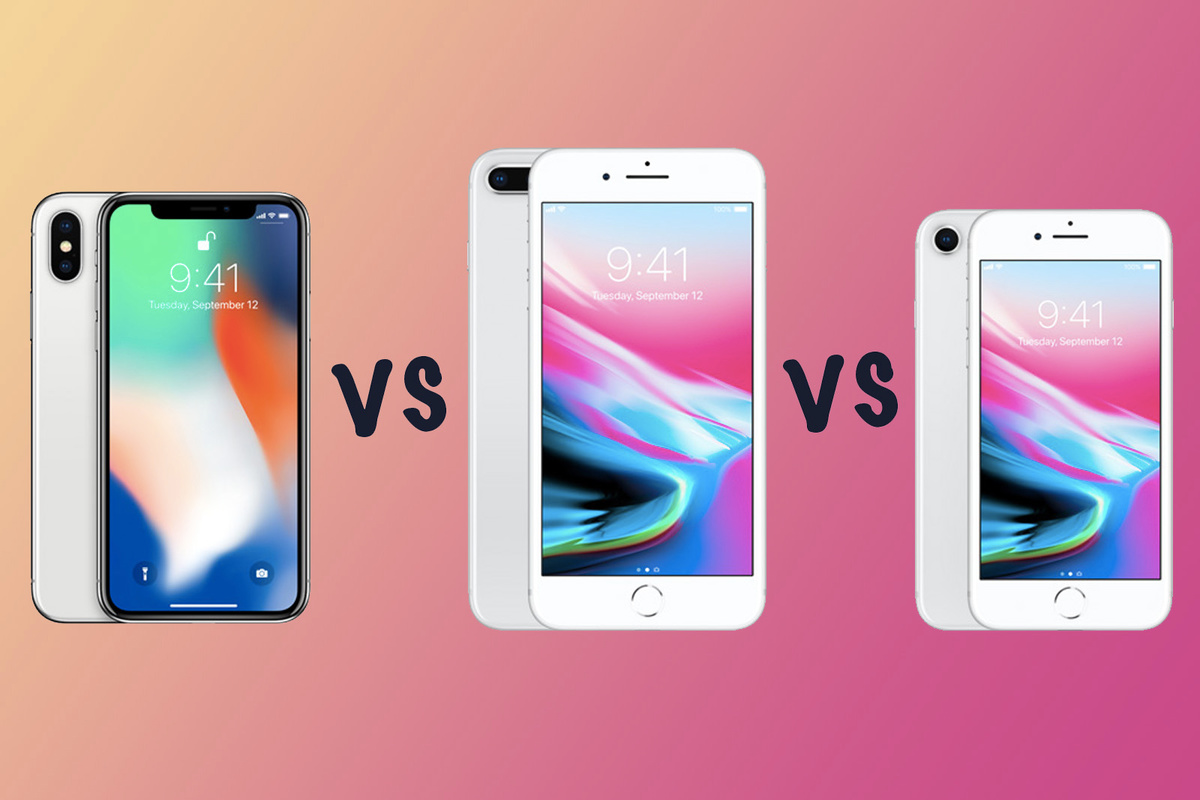Many new features offered by Apple in 2017 are common to all three phones: they all incorporate the Apple A11 Bionic, True Tone screen, wireless charging, at least 64 GB storage and the same accessories. So what are the differences between the three products?
iPhone 8 vs iPhone X: same clutter, but great differences
We start with a comparison between the basic model, the iPhone 8, and the most expensive model, the iPhone X. For many, the iPhone 8 is actually an iPhone 6sss, indeed the brand did not basically changed its design and is content with the few adjustments one would have expected from an iPhone 7s, and as the iPhone 7 was itself a kind of iPhone 6s.
Antique design vs. OLED screen edge to edge
The most obvious is the integration of the 5.8-inch OLED screen edge-to-edge of 2436 x 1125 pixels facing the old-fashioned IPS screen (although of very good quality) 4.34 inches x 1334 x 750 pixels from the iPhone 8. Despite the use of a screen with a larger diagonal, the iPhone X is not really more cumbersome than the iPhone 8: 143.6 x 70.9 x 7.7 mm against 138.4 x 67.3 x 7.3 mm for the iPhone 8.
Face ID vs. Touch ID: Will animojis make the difference?
The use of an edge-to-edge screen on the iPhone X forced Apple to review its biometric identification solution. The iPhone X uses a rather sophisticated Face ID face recognition , instead of the Touch ID fingerprint sensor still used on the iPhone 8.
This means that to unlock an iPhone X it is necessary that your face is in its field of vision, whereas the iPhone 8 can be turned more discreetly, and faster from your pocket. Face ID could however be more transparent to use and be forgotten, what is required of this kind of technology.
The difference will ultimately be on other functions permitted by the front 3D sensor used by Face ID. This sensor will unlock the augmented reality uses on the iPhone X, which are missing on the iPhone 8. We are talking about Portrait Lighting, Animojis and Snapchat filters .
The rear camera: the advantages of Plus in a compact body
The iPhone X has a camera with two sensors similar to those of the iPhone 7 Plus and the iPhone 8 Plus. Like the iPhone 7, the iPhone 8 must be satisfied with its mono sensor and is therefore not compatible with certain functions like the portrait mode.
In any case, the 12 megapixel sensors used by Apple have changed between 2016 and 2017. The brand now uses “bigger”, faster, and better noise sensors. The main objective is the same in both cases, open at f / 1.8 and equipped with optical stabilization. Finally the flash uses 4 LEDs in both cases.
The difference comes of course from the second sensor available on the iPhone 8 Plus and the iPhone X. In the case of iPhone X, it is a 12 megapixel sensor with a f / 2.4 telephoto lens which also has optical stabilization.
A little more battery and RAM on the iPhone X
This round of differences is completed by the battery and the RAM. The iPhone X has 3 GB of RAM against 2 GB for the iPhone 8 and a better autonomy, according to Apple, since the iPhone X would be able to hold 60 hours in audio playback, against 40 hours for ‘iPhone 8. The autonomy in video playback and browsing on the Internet is identical according to Apple between the two products.
There are even fewer differences between the iPhone 8 Plus and the iPhone X, in reality there are only three.
Difference 1: OLED screen edge to edge
We will not go back on it, the iPhone X offers an edge-to-edge OLED screen, which allows it to have a 5.8-inch screen in a chassis more compact than the iPhone 8 Plus, whose IPS screen is 5.5 inches diagonal.
Difference 2: Face ID sensor
As in the case of the iPhone 8, the use of an edge-to-edge screen on the iPhone X prompted Apple to integrate a front-facing 3D sensor for the Face ID function. The iPhone 8 Plus therefore offers a Touch ID fingerprint sensor, but will not be able to offer certain functions like animojis.
Difference 3: optical stabilization of the second dorsal device
The iPhone 8 Plus and the iPhone X offer almost the same back camera: same ISP, same sensors, same objectives, etc. The only difference between the two devices is that the iPhone X incorporates optical stabilization for the second sensor.
That’s all
And that’s all, the iPhone 8 Plus incorporates the same battery, the same processor, the same amount of RAM, wireless charging, True Tone screen, water resistance, 64 to 256 GB storage, the same 4K recording at 60 frames per second and the same Lightning wired headphones.
Conclusion: The iPhone X, an iPhone 8 Plus in the body of an iPhone 8
Ultimately, we understand that the OLED screen and the Face ID sensor will be the two assets of the iPhone X facing the iPhone 8 and the iPhone 8 Plus. The use of an edge-to-edge OLED screen, similar to what Essential, LG and Samsung offer, finally allows Apple to review the design of its phone.
The iPhone X is simply an iPhone 8 Slightly improved, with an OLED screen but with the compactness of an iPhone 8.

Leave a Reply